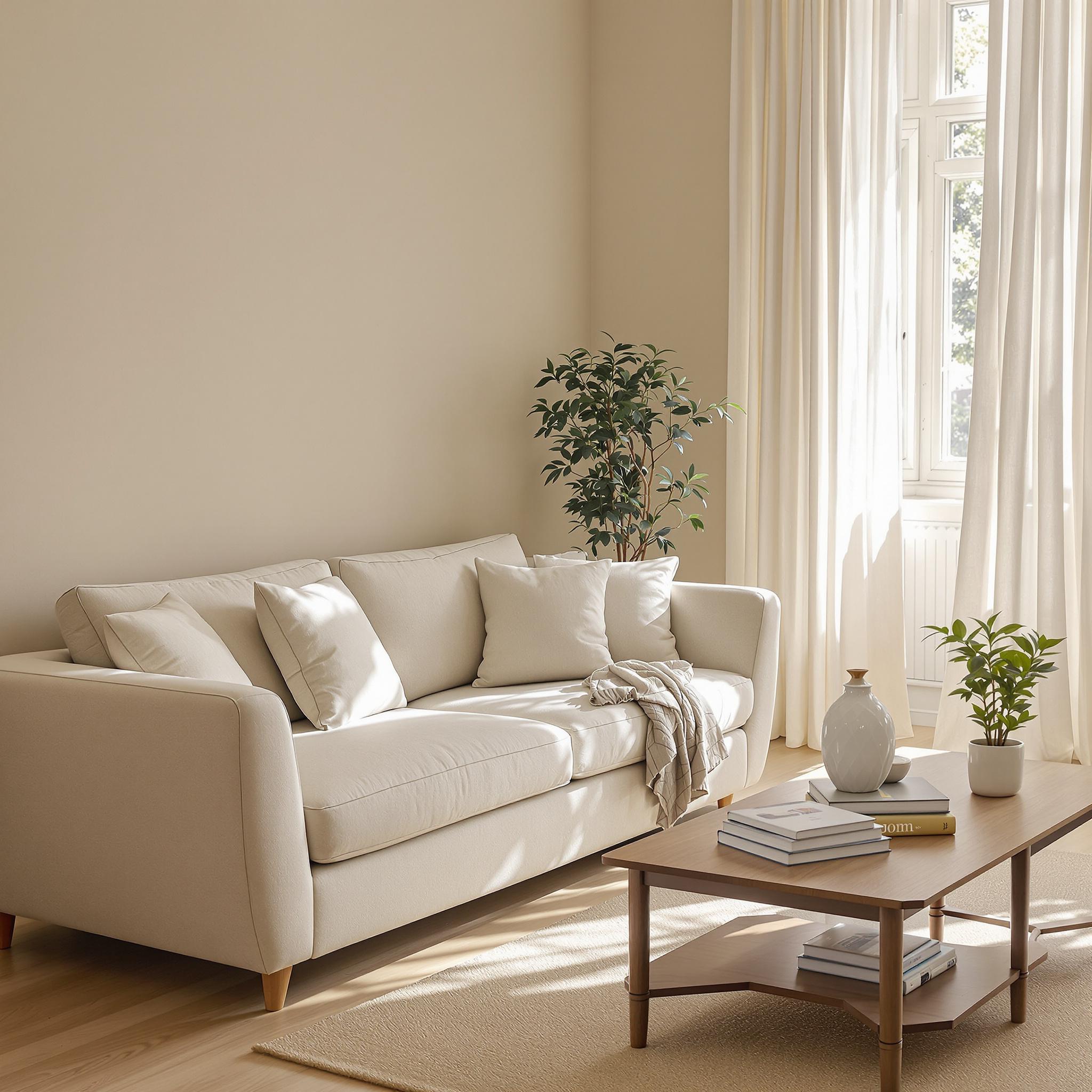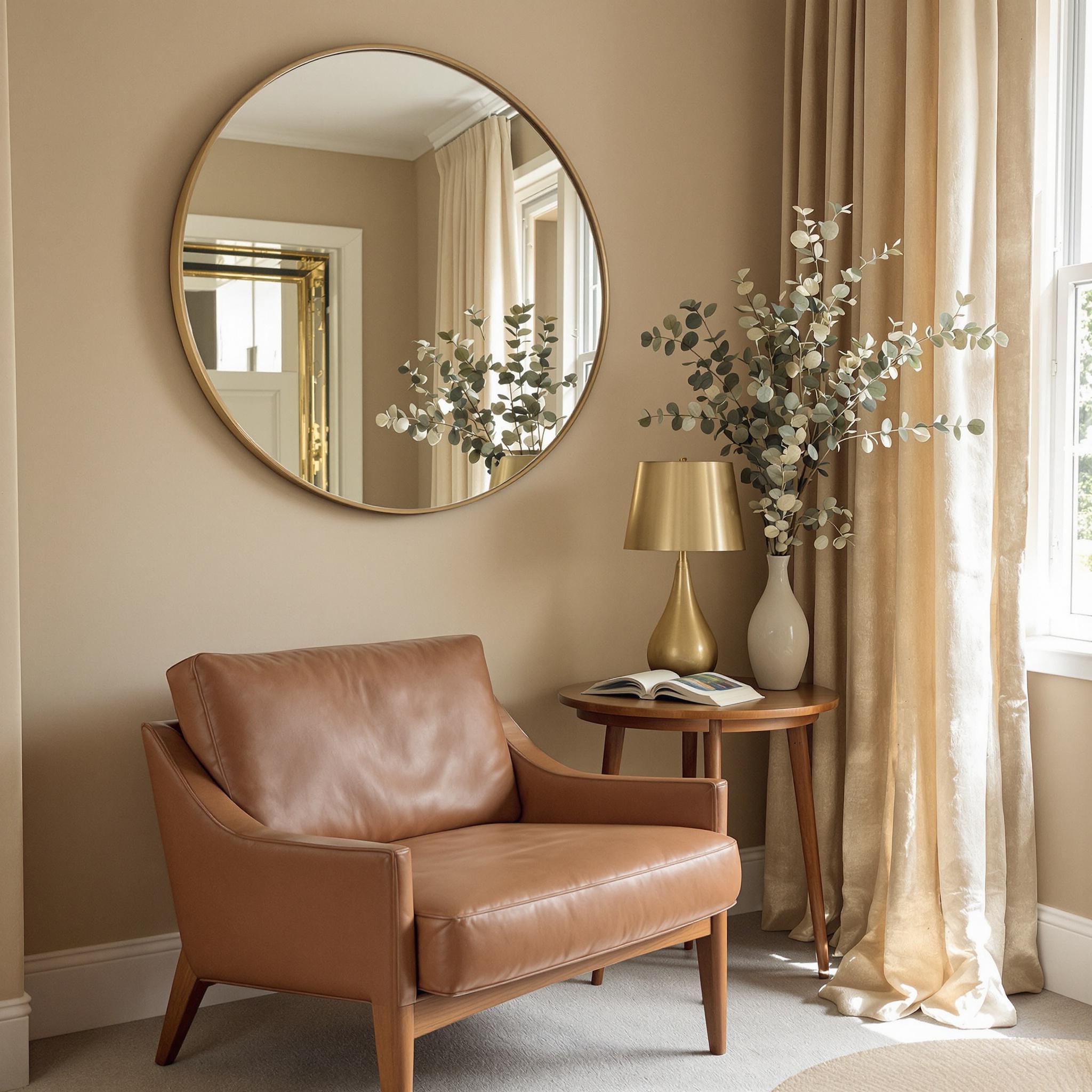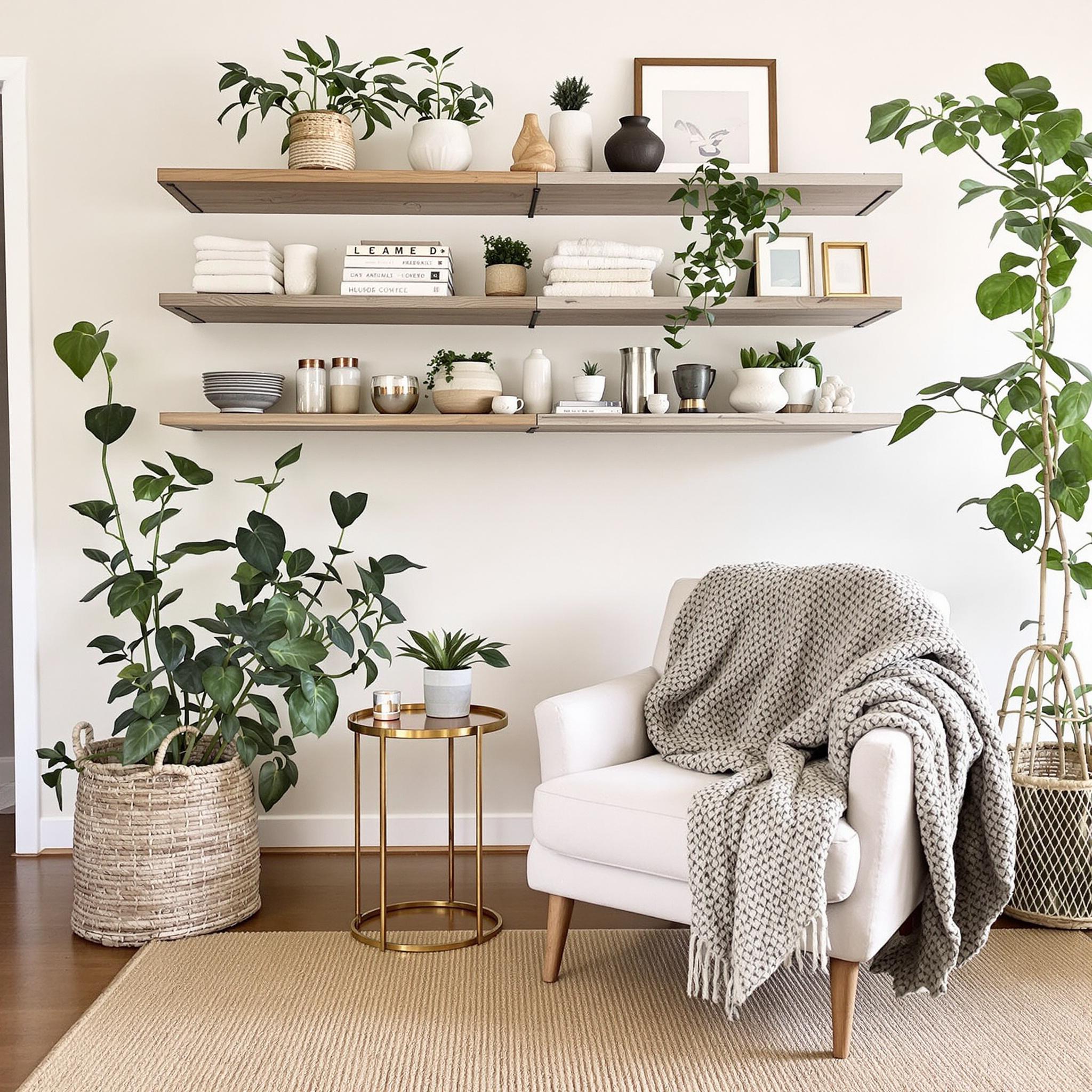What Are Soft Neutrals and Why Do They Matter?
Soft neutrals are calming colors like beige, taupe, and ivory. They feel soothing because they mimic nature. These hues don’t overpower a space. Instead, they create balance. Think of them as the backdrop for your living room.
These colors have a psychological impact. They reduce stress and promote relaxation. Imagine walking into a room painted in soft gray. It feels peaceful, doesn’t it? That’s why designers love using them.
Soft neutrals work well with any style. Whether your home is modern or rustic, they fit right in. They also make spaces look bigger. Light reflects off these tones easily. This creates an airy, open feel.
Natural Woods: The Heart of Warmth and Authenticity
Natural woods bring life to any room. They come in many finishes—oak, walnut, pine, and more. Each type has its own texture and tone. Some are smooth and sleek, while others are rough and rugged.
- Oak is durable and has a classic look.
- Walnut adds richness with its deep brown hue.
- Pine offers a lighter, casual vibe.
Wood textures add depth. A reclaimed wood coffee table tells a story. Its knots and grains show character. Even small touches, like wooden picture frames, make a difference.
These materials feel real. In a world full of plastic, wood stands out. It connects us to nature. This authenticity makes rooms inviting. Wood warms up spaces without overwhelming them.
Why Soft Neutrals and Natural Woods Work Together
The mix of soft neutrals and natural woods is magic. Neutrals act as a canvas. Woods add visual interest. Together, they create harmony.
Imagine a beige sofa paired with a walnut side table. The contrast feels cozy yet refined. Or think about taupe walls with oak flooring. The combination grounds the space.
This pairing works because it’s balanced. Neutrals keep things calm. Woods introduce warmth. Neither element fights for attention. Instead, they enhance each other.
I once redesigned a client’s living room with this combo. They wanted something timeless but fresh. We used soft gray walls and added teak shelves. The result? A space that felt both modern and welcoming.
Current Trends and Timeless Appeal
This aesthetic fits perfectly into today’s design trends. People crave simplicity. Minimalism is popular, but it can feel cold. Adding wood prevents this. It keeps things warm and livable.
Soft neutrals never go out of style. They adapt to changing tastes. Pair them with bold accents for a trendy look. Or stick to classic decor for timelessness.
Modern design values function and beauty. This combo checks both boxes. It’s practical yet elegant. For example, neutral rugs hide stains. Wooden furniture lasts for years.
Even tech-focused homes benefit from this mix. Smart gadgets often look sleek and metallic. Wood tones soften their appearance. They make technology blend seamlessly into the decor.
Think about Scandinavian design. It’s clean, simple, and functional. Yet it always includes wood. This shows how universal this pairing is. It suits all kinds of interiors.
Tips for Using Soft Neutrals and Natural Woods
Start by choosing one dominant neutral. Then layer different wood tones. Mix light and dark shades for contrast. Avoid overloading on either element.
Add textiles for extra comfort. Linen curtains or wool throws pair beautifully. These materials complement wood and neutrals.
Don’t forget lighting. Natural light enhances this aesthetic. Position furniture near windows. Use warm bulbs to highlight wood grains at night.
Incorporate plants for freshness. Greenery pops against soft neutrals. It also ties back to the natural theme. Try potted ferns or succulents.
Remember, less is more. Too many patterns or colors disrupt the balance. Stick to subtle details. Let the materials speak for themselves.
Final Thoughts Before Moving Forward
Soft neutrals and natural woods are versatile. They suit any home, big or small. This duo creates spaces that feel lived-in yet polished.
Whether you’re redecorating or starting from scratch, consider this combo. It’s not just a trend. It’s a way to build lasting beauty.
Choosing the Right Color Palette: Soft Neutrals That Sing with Natural Woods
Let’s dive into color palettes. Ever stood in front of paint swatches, overwhelmed by beige options? I’ve been there. Once spent an hour debating between “Warm Sand” and “Desert Dune.” Turns out, they looked almost the same under different lights. But soft neutrals are magic. They set the tone without stealing attention.
Pairing neutrals with wood is about harmony, not contrast. Creamy whites, warm taupes, or soft grays let wood tones pop. Oak has golden undertones, so warmer neutrals like beige work well. Walnut’s darker hues pair nicely with cool shades like light gray or pale blue-gray. I once painted a room charcoal gray thinking it would look sleek with teak furniture. Big mistake—it felt too heavy. Switching to dove gray made the space calm and inviting.
Pro tip: test paint samples on your walls. Live with them for a few days. Check how they look in morning sunlight versus evening lamplight. Accent walls can add interest too. A muted terracotta or sage green keeps things calm but adds depth.
Furniture Selection: Letting Natural Woods Steal the Show
Now, onto furniture—the fun part of any home project. When working with natural woods, pick timeless pieces that feel personal. Whether it’s a mid-century oak sideboard from your grandparents or a walnut dining table you saved up for, let your furniture tell a story.
Oak feels friendly, walnut feels polished, and teak brings durability and global flair. My favorite piece is a vintage teak coffee table I found at a flea market. It’s scratched up, but those imperfections give it character.
Upholstery matters too. Stick with neutral fabrics like linen, cotton, or wool. They blend well with wood and add texture. For example, a caramel leather chair with a light oak bookshelf creates a cozy reading nook.
Don’t stress about matching wood tones perfectly. Mixing woods adds dynamism. Just keep one tone dominant. Pair dark walnut with lighter pine or birch for balance.
Layering Textures: Adding Depth Without Overdoing It
Confession: I used to think layering textures was just fancy talk. Then I tried it. It makes a huge difference. A room with flat surfaces might look okay, but it won’t feel inviting. Textures bring warmth and personality.
Start with rugs—they’re essential. A chunky jute rug works wonders on smooth wooden floors. Or try a sheepskin throw over a chair for instant coziness. In my bedroom, I layered a wool rug over hardwood and added a knitted pouf. Sounds random, but it works.
Cushions and throws are easy ways to add texture. Mix fabrics like velvet, linen, and knit. Keep colors neutral—a cream linen pillow next to a taupe velvet one stays cohesive. Curtains help too. Heavy linen drapes soften windows and filter light beautifully.
But don’t overdo it. Too many textures can overwhelm. Stick to two or three key pieces per area and let the rest breathe.
Strategic Use of Lighting: Turning Up the Cozy Vibes
Lighting can make or break a room. Get it wrong, and even a cozy setup falls flat. Get it right, and your space feels like a dream.
Maximize natural light. Big windows help, but if you don’t have them, use mirrors to bounce light around. I hung a large round mirror opposite my living room window. The room feels brighter now.
For artificial lighting, choose fixtures that fit the vibe. Warm Edison bulbs in industrial pendants or brass sconces with soft shades work well. Table lamps with linen or paper shades cast a gentle glow. Dimmer switches are a game-changer—they let you control the mood.
And don’t forget candles. Flickering candlelight against wood is magical. Scented candles boost the mood too—I love vanilla or sandalwood.
Balancing Minimalism and Coziness: Finding Your Sweet Spot
Here’s the big question: how do you balance minimalism and coziness? You don’t want a sterile showroom, but cluttered chaos isn’t the answer either.
Edit thoughtfully. Declutter, but keep items that spark joy or serve a purpose. I kept my vintage ceramic vases and styled them on open shelves with books and plants. Instant warmth.
Incorporate organic shapes. A rounded sofa or oval coffee table breaks up sharp angles. Plants help too. A fiddle-leaf fig or succulents add life without disrupting the palette.
Funny story: I stripped my bedroom down to just a bed frame and nightstand. It felt cold and unwelcoming. Adding a woven basket, magazines, and a side chair fixed it. Lesson learned: minimalism doesn’t mean empty.
Ultimately, designing with neutrals and wood is about creating a space that feels like you. Choose colors, furniture, textures, and lighting that reflect your personality while offering comfort and style.
Adding Those Little Wow Factors: Accent Elements That Bring Life to Your Space
You know how it goes—small details can make a big difference. Accent pieces are like the secret sauce in your favorite meal. They pull everything together. Think metallics, plants, and art. These aren’t just finishing touches—they’re what makes a room pop.
Let’s talk about metallics first. A gold lamp or copper table can add a little sparkle that catches the light. I once bought a tiny brass tray thinking it’d be cute but forgettable. Turns out, it became my favorite piece because it added warmth. Pro tip: one or two metallic items are enough. You don’t want it to look like a disco ball blew up.
Now, plants. Who doesn’t love a bit of green? Plants soften neutral tones and woods, making spaces feel alive. If you’re worried about killing them, try low-maintenance options like snake plants or pothos. Fun fact: NASA says some houseplants clean the air. So you’re not just decorating—you’re purifying too.
And then there’s art. Whether it’s bold abstracts or calming landscapes, art tells a story. I have an old black-and-white photo of Paris above my couch. It reminds me of a trip I loved. The key is picking something that speaks to you. Don’t stress about matching—it’s more about how it makes you feel.
Going Green: Why Sustainable Choices Matter More Than Ever
We spend so much time worrying about how our homes look, but sometimes forget their impact on the planet. Good news: you can have both—a stylish and eco-friendly space. Sustainable choices aren’t just trendy—they’re smart.
When shopping for furniture, look for reclaimed wood or FSC-certified timber. These materials keep forests healthy while giving you that natural vibe. For fabrics, go with organic cotton, linen, or hemp. They’re better for the environment—and often softer on your skin.
I recently swapped my synthetic rug for a jute one. What a change! It fits my neutral palette perfectly, and knowing it’s biodegradable feels good. Plus, it smells earthy when new. (Okay, maybe not “earthy cookies,” but you get the idea.)
Sustainability isn’t just about buying new stuff. Use what you already own. Got an old chair? Reupholster it instead of tossing it. Or give second-hand finds a makeover. My neighbor turned a thrifted dresser into a media console. It looks amazing.
Maintaining the Magic: Cleaning Tips and Fabric Care
Confession: I used to dread cleaning my wood furniture. I thought I’d ruin it. Turns out, it’s easy if you know what to do. Skip harsh chemicals. Just use a damp cloth and mild soap. Dry it right away to avoid water spots. Done.
For fabrics, especially neutrals, prevention is key. Spills happen. Blot them fast with a clean cloth—don’t rub, or the stain will set. If you’ve got kids, pets, or clumsy adults (guilty), treat upholstery with a fabric protector spray. It’s a lifesaver.
Funny story: I spilled red wine on my beige couch. Total freak-out. But baking soda and vinegar saved the day. Lesson learned: always keep these around.
Oh, and vacuum regularly—even if it doesn’t look dusty. Dust dulls fabrics over time. Trust me, your textiles will thank you.
Adapting Without Losing Your Style: Seasonal Refreshes and Trend Updates
One of the best things about a neutral and wood theme is its flexibility. You can tweak it seasonally without losing its essence. In winter, swap lightweight throws for chunky blankets. Add cozy textures like faux fur. In summer, lighten up with crisp linens and pastel pillows.
Trends come and go, but timeless design sticks around. That said, it’s okay to experiment. Maybe this year’s hot color is sage green. Add a pillow or vase in that shade to nod to trends without overwhelming your space. Real talk: I tried neon pink last year and hated it instantly. Small updates are safer.
Speaking of updates, real-life transformations inspire me. Remember Sarah down the street? Her living room went from cluttered chaos to calm sanctuary. She said, “It feels like a hug every time I walk in.” Isn’t that what home should feel like?
Final Thoughts: Creating a Living Room That Feels Like Home
At the end of the day, your living room should reflect who you are while staying comfy and functional. With thoughtful accents, sustainable practices, and proper maintenance, you can create a space that grows with you. So go ahead—add that plant, switch out those pillows, and enjoy the process. Your home is your canvas, and you’re the artist.
Frequently Asked Questions
- How do I choose the right size rug for my living room?
Get a rug big enough for your furniture. Ideally, all four legs of your sofa and chairs should sit on it. Measure your space first. - Can I mix different wood tones in my living room?
Yes! Mixing woods adds depth. Just ensure they share similar undertones (warm or cool) and balance them with colors or textures. - What’s the best way to clean natural wood floors?
Sweep daily and mop weekly with a pH-neutral cleaner. Avoid soaking the floor. Use felt pads under furniture to prevent scratches. - How can I make my living room feel cozier?
Layer textures with rugs, cushions, and throws. Add dimmable lights and personal items like books or photos for warmth. - Are houseplants safe for pets?
Some plants, like lilies and philodendrons, are toxic to pets. Stick to pet-safe options like spider plants or Boston ferns. - How do I protect my neutral sofa from stains?
Use a fabric protector spray and washable slipcovers. Keep a stain remover handy. Vacuum regularly to reduce dirt buildup. - What eco-friendly alternatives exist for traditional paint?
Look for zero-VOC or low-VOC paints. Brands like Benjamin Moore and Sherwin-Williams offer great eco-friendly options. - How do I refresh my living room for spring?
Swap heavy fabrics for lighter ones. Add floral patterns and brighter colors. Declutter and deep-clean for a fresh start. - Is reclaimed wood durable enough for furniture?
Yes, reclaimed wood is often stronger due to its age. Make sure it’s treated and sealed for longevity. - Where can I find affordable sustainable decor?
Check thrift stores, flea markets, and Etsy. DIY projects with recycled materials are another budget-friendly option.



